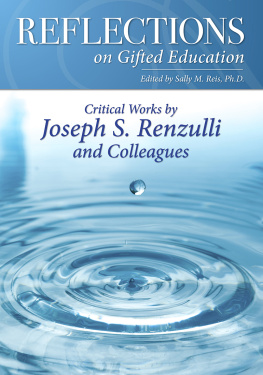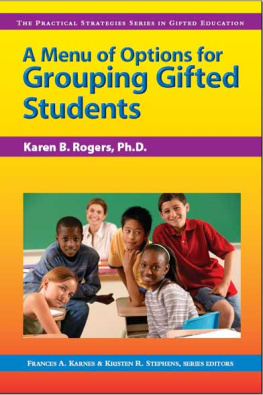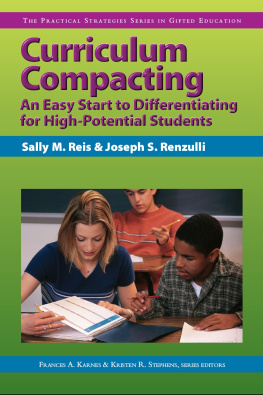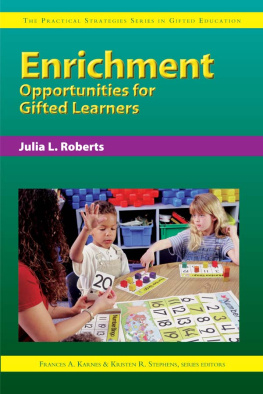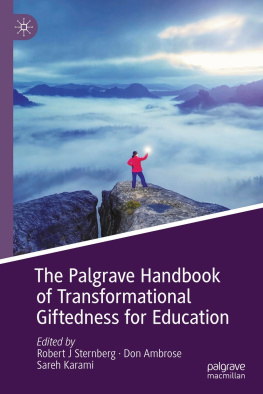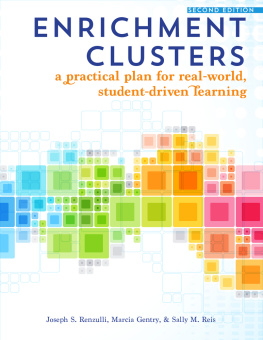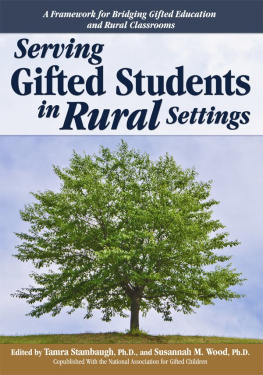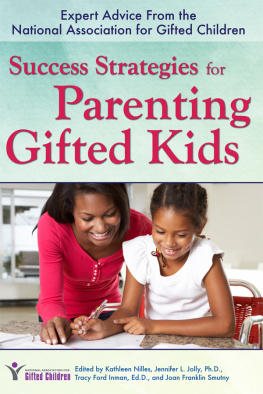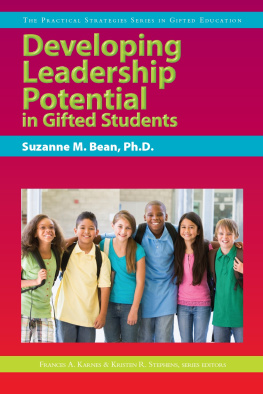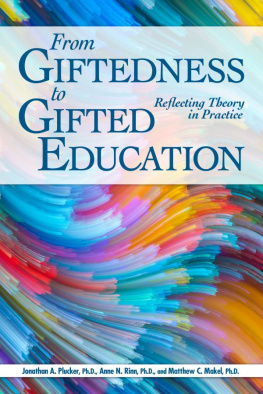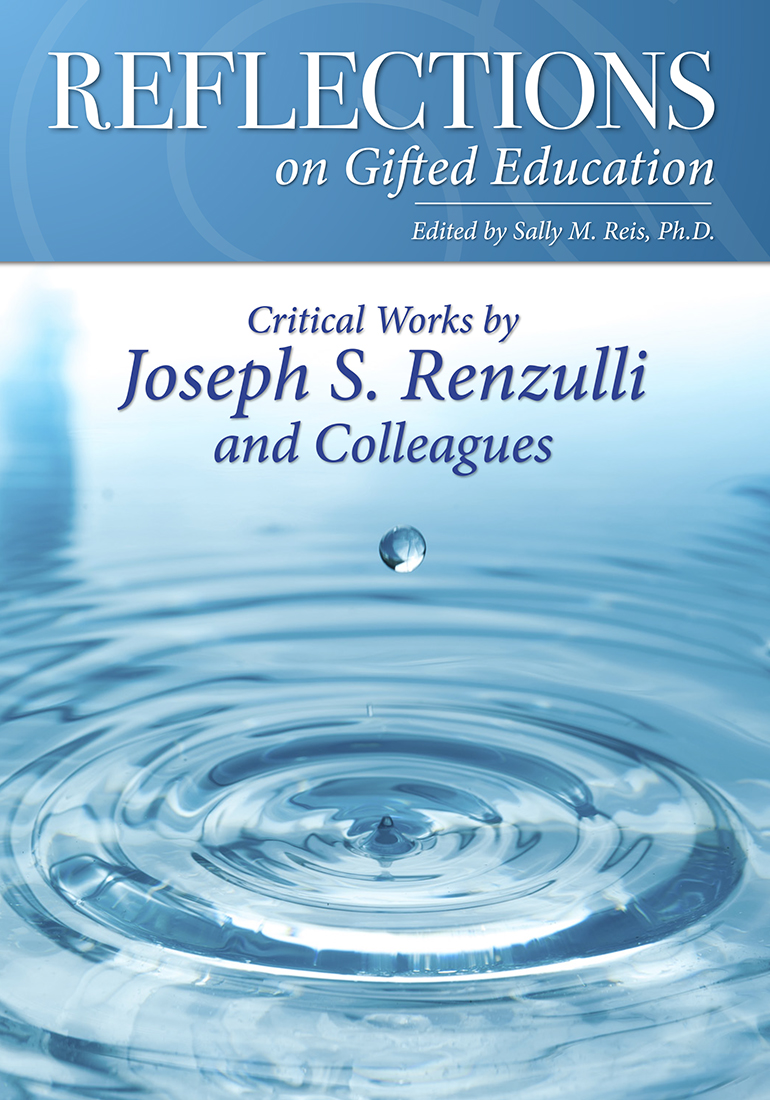
REFLECTIONS
on Gifted Education

Dedication
To all of the innovative and dedicated teachers and administrators with whom we have had the opportunity to work over the decades and the many ideas they have contributed to the evolution of our work.
Copyright 2016 Prufrock Press Inc.
Edited by Lacy Compton
Cover and layout design by Raquel Trevino
ISBN-13: 978-1-61821-507-9
No part of this book may be reproduced, translated, stored in a retrieval system, or transmitted, in any form or by any means, electronic, mechanical, photocopying, microfilming, recording, or otherwise, without written permission from the publisher.
At the time of this books publication, all facts and figures cited are the most current available. All telephone numbers, addresses, and websites URLs are accurate and active. All publications, organizations, websites, and other resources exist as described in the book, and all have been verified. The authors and Prufrock Press Inc. make no warranty or guarantee concerning the information and materials given out by organizations or content found at websites, and we are not responsible for any changes that occur after this books publication. If you find an error, please contact Prufrock Press Inc.

| Prufrock Press Inc.
P.O. Box 8813
Waco, TX 76714-8813
Phone: (800) 998-2208
Fax: (800) 240-0333
http://www.prufrock.com |
Table of Contents

Preface
An Introduction, Some Personal Stories From Some Very Special People, and a Readers Guide
Sally M. Reis
University of Connecticut
If you dont know where youre going, you might wind up someplace else.
Yogi Berra
Guiding readers through this book is both a privilege and pleasure. Organizing this volume of collected works by my husband and partner Joe Renzulli and the many colleagues whose work has been influenced by his ideas may appear, at first glance, to be an easy and even enjoyable task. However, it was more challenging than I originally thought, for Joes work is voluminous, consisting of literally hundreds of articles, books, chapters, and research monographs. I was pretty sure that I knew his most important and wide-reaching ideas, but I did some checking of various citation indices to verify my hunches.
After reading his introductory chapter, however, I realized that although his research articles and reports are of course widely cited, the foundation that has guided his lifes work has been the translation of his research findings into practical suggestions about identification and programming that work in classrooms. He constantly reminds his colleagues and graduate students that teachers know most about what works in their classrooms. Impact points in academe are a function of citations by other researchers, but Joe has judged his own impact on the field by how many schools and teachers actually implement his many creative ideas. He often cites his proudest professional accomplishment as the pages and pages of charts, tables, statistics, and research designs that underlie his work that are widely available on the Neag Center for Gifted Education and Talented Development website (http://www.gifted.uconn.edu).
The idea behind this book has been to collect Joes most important ideas in one place. These ideas have practical value for anyone seeking to implement what might can be described as a brand of gifted education and talent development that differs from traditional approaches in this field. The focus of this brand is not so much about how we group students and move them around as what we do with them in any organizational or administrative arrangement. And this brand is especially concerned with how we engage students in joyful learning rather than just what or how much we teach to them. Joe has always said that Enjoyment, Engagement, and Enthusiasm for Learning should be the goals of any special opportunities we provide to students.
One Personal Story
I met Joe soon after I moved back to my Connecticut hometown from Pittsburgh, PA. I had become interested in gifted and talented students as a result, like so many of my colleagues, of my work as an English teacher in a large public junior high school that served students in grades 79. I had the classic exposure to the need to know more about gifted educationan incredibly smart and turned-off student who had absolutely no interest in learning anything in my class and whose motivation was waning by the day. Reading about what to do with gifted students brought me to the work of James Gallagher and classes at the University of Pittsburgh in gifted education. Eventually, Jack Birch at the University of Pittsburgh recommended that when I returned to my home state of Connecticut, I contact a young guy at UConn named Joe Renzulli. I did just that and in 1976, Joe sent me a mimeographed copy of a two-part article he had written on the Enrichment Triad Model. This was my first exposure to his work and the ideas that would influence the rest of my professional and personal life.
As I had already taken a couple classes in this area, and had become interested in learning more, I asked him about additional classes at UConn and instead, he sent me to Southern Connecticut State University and Dr. Linda Smith who had begun teaching graduate classes there and needed more students. One of Joes most endearing characteristics is the generosity with which he helps his former and current students. So rather than register for one of Joes classes, I ended up enrolling in classes at Southern with Linda and within a year, I had talked three of my friends, all of whom were interested in gifted and talented students into joining me on my weekly trek to New Haven, CT. Peg Beecher, Mary Cianciolo, Sandy Turnquist Buckland, and I traveled together, stopping to eat well and laughing most of the way down to our classes. We were young, irreverent, and considered ourselves wildly creative teachers. It was in one of those classes that I met Joe, who was invited to give a guest lecture.
Joe and I have been best friends for a very long time. What I love most about him is his remarkable energy and passion for lifefor his wife and children and family, as well as his work, ideas, cooking, love of travel, excitement in small victories, and for his constant quest to evolve. I also take pride in the joy he feels related to the outcomes of his successful work, as he loves seeing the many and diverse ways that students complete in-depth projects. He is passionate about the schools that use the Schoolwide Enrichment Model, and all of the administrators and teachers who seek a better way of engaging and enriching their students experiences. He loves people who question authority, especially when that authority results in rigid and noncreative educational experiences for young people. Joes ideas ignited my ownas a teacher of gifted students in my own hometown of Torrington, CT, then as a coordinator, and then as a researcher and his partner in work and life.
Joe became and remains an ardent supporter of educators who question the status quo and are not afraid to work and fight for change. He has always looked for and brought out the best in those with whom he works. His questions and quest for excellence have made my work stronger but at the end of more than three decades together, he is still my best friend and our marriage is strong and happy. What makes me proudest of him? So many things come to mindhis need to evolve and change and improve based on data and field testing; his passion for me and our family, his life, and his work, his ability to be steadfast and noble; his creativity and constant need for movement in a new direction; and perhaps, most of all, his intellectual curiosity. In this book, you will see the evolution of some of his ideas and also, some of the refinements that emerged because of his need to conduct research that became the cornerstone of his work. If his initial ideas are not practical or easy to implement by teachers, they are eventually discarded in favor of finding ones that can be more simply implemented in schools.
Next page
